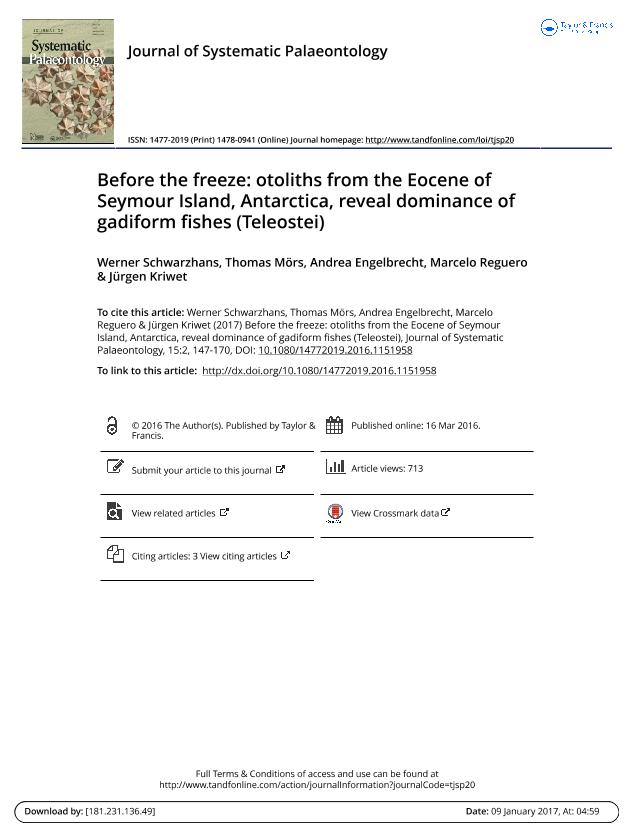Mostrar el registro sencillo del ítem
dc.contributor.author
Schwarzhans, Werner
dc.contributor.author
Mörs, Thomas
dc.contributor.author
Engelbrecht, Andrea
dc.contributor.author
Reguero, Marcelo Alfredo

dc.contributor.author
Kriwet, Jürgen
dc.date.available
2018-06-22T17:50:51Z
dc.date.issued
2017-02
dc.identifier.citation
Schwarzhans, Werner; Mörs, Thomas; Engelbrecht, Andrea; Reguero, Marcelo Alfredo; Kriwet, Jürgen; Before the freeze: otoliths from the Eocene of Seymour Island, Antarctica, reveal dominance of gadiform fishes (Teleostei); Cambridge University Press; Journal of Systematic Palaeontology; 15; 2; 2-2017; 147-170
dc.identifier.issn
1477-2019
dc.identifier.uri
http://hdl.handle.net/11336/49666
dc.description.abstract
The first record of fossil teleostean otoliths from Antarctica is reported. The fossils were obtained from late Early Eocene shell beds of the La Meseta Formation, Seymour Island that represent the last temperate marine climate phase in Antarctica prior to the onset of cooling and subsequent glaciation during the late Eocene. A total of 17 otolith-based teleost taxa are recognized, with 10 being identifiable to species level containing nine new species and one new genus: Argentina antarctica sp. nov., Diaphus? marambionis sp. nov., Macruronus eastmani sp. nov., Coelorinchus balushkini sp. nov., Coelorinchus nordenskjoeldi sp. nov., Palimphemus seymourensis sp. nov., Hoplobrotula? antipoda sp. nov., Notoberyx cionei gen. et sp. nov. and Cepola anderssoni sp. nov. Macruronus eastmani sp. nov. is also known from the late Eocene of Southern Australia, and Tripterophycis immutatus Schwarzhans, widespread in the southern oceans during the Eocene, has been recorded from New Zealand, southern Australia, and now Antarctica. The otolith assemblage shows a typical composition of temperate fishes dominated by gadiforms, very similar at genus and family levels to associations known from middle Eocene strata of New Zealand and the late Eocene of southern Australia, but also to the temperate Northern Hemisphere associations from the Paleocene of Denmark. The Seymour Island fauna bridges a gap in the record of global temperate marine teleost faunas during the early Eocene climate maximum. The dominant gadiforms are interpreted as the main temperate faunal component, as in the Paleocene of Denmark. Here they are represented by the families Moridae, Merlucciidae (Macruroninae), Macrouridae and Gadidae. Nowadays Gadidae are a chiefly Northern Hemisphere temperate family. Moridae, Macruroninae and Macrouridae live today on the lower shelf to deep-water or mesopelagically with Macruroninae being restricted to the Southern Ocean. The extant endemic Antarctic gadiform family Muraenolepididae is missing, as are the dominant modern Antarctic fishes of the perciform suborder Notothenioidei. Recently, there has been much debate on isolated jaw bones of teleost fishes found in the La Meseta Formation and whether they would represent gadiforms (Merlucciidae in this case) or some early, primitive notothenioid. Otoliths are known to often complement rather than duplicate skeletal finds. With this in mind, we conclude that our otolith data support the presence of gadiforms in the early Eocene of Antarctica while it does not rule out the presence of notothenioids at the same time. http://zoobank.org/urn:lsid:zoobank.org:pub:A30E5364-0003-4467-B902-43A41AD456CC
dc.format
application/pdf
dc.language.iso
eng
dc.publisher
Cambridge University Press

dc.rights
info:eu-repo/semantics/openAccess
dc.rights.uri
https://creativecommons.org/licenses/by-nc-sa/2.5/ar/
dc.subject
Antarctica
dc.subject
Eocene
dc.subject
Gadiformes
dc.subject
Macrouridae
dc.subject
Macruronus
dc.subject
Temperate Climate
dc.subject.classification
Meteorología y Ciencias Atmosféricas

dc.subject.classification
Ciencias de la Tierra y relacionadas con el Medio Ambiente

dc.subject.classification
CIENCIAS NATURALES Y EXACTAS

dc.title
Before the freeze: otoliths from the Eocene of Seymour Island, Antarctica, reveal dominance of gadiform fishes (Teleostei)
dc.type
info:eu-repo/semantics/article
dc.type
info:ar-repo/semantics/artículo
dc.type
info:eu-repo/semantics/publishedVersion
dc.date.updated
2018-06-21T12:57:53Z
dc.journal.volume
15
dc.journal.number
2
dc.journal.pagination
147-170
dc.journal.pais
Reino Unido

dc.journal.ciudad
Cambridge
dc.description.fil
Fil: Schwarzhans, Werner. Ahrensburger Weg 103; Alemania. Natural History Museum of Denmark; Dinamarca
dc.description.fil
Fil: Mörs, Thomas. Swedish Museum of Natural History; Suecia
dc.description.fil
Fil: Engelbrecht, Andrea. Universidad de Viena; Austria
dc.description.fil
Fil: Reguero, Marcelo Alfredo. Consejo Nacional de Investigaciones Científicas y Técnicas; Argentina. Universidad Nacional de La Plata. Facultad de Ciencias Naturales y Museo. Departamento Científico de Paleontología de Vertebrados; Argentina
dc.description.fil
Fil: Kriwet, Jürgen. Universidad de Viena; Austria
dc.journal.title
Journal of Systematic Palaeontology

dc.relation.alternativeid
info:eu-repo/semantics/altIdentifier/doi/https://dx.doi.org/10.1080/14772019.2016.1151958
dc.relation.alternativeid
info:eu-repo/semantics/altIdentifier/url/https://www.tandfonline.com/doi/full/10.1080/14772019.2016.1151958
Archivos asociados
